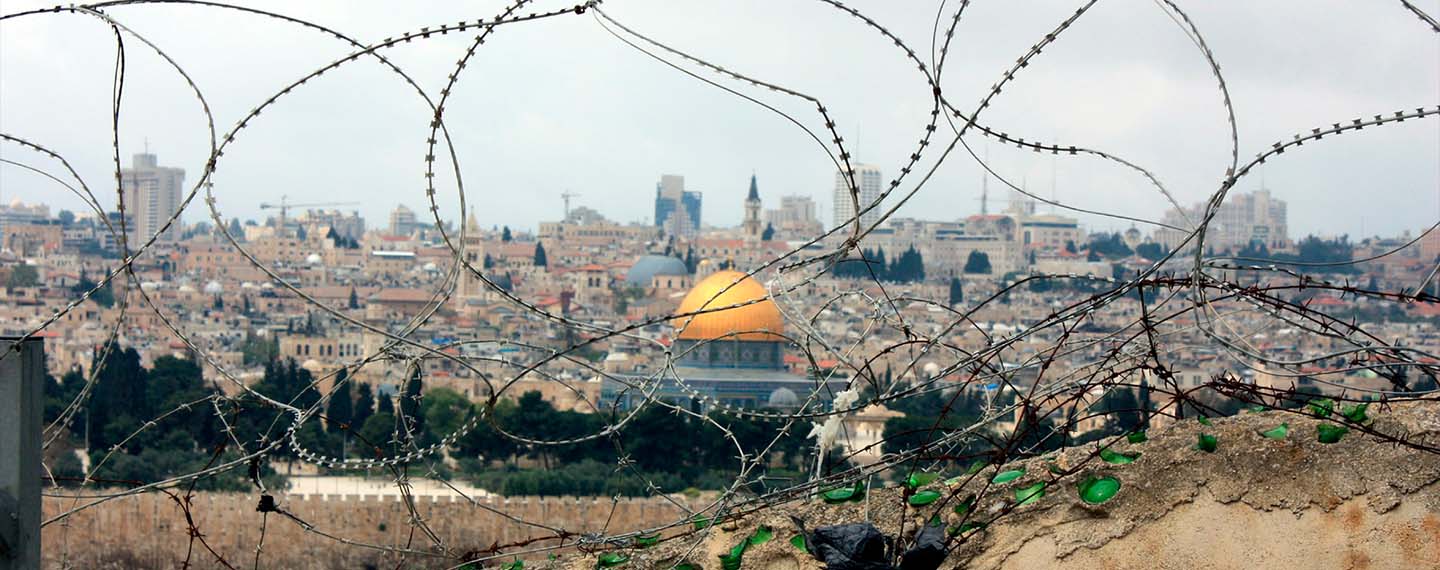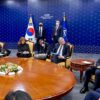Theme
Israel’s intelligence, military and government all failed to anticipate Hamas’s Operation Al-Aqsa Flood. Why?
Summary
On 7 October the state of Israel witnessed one of the darkest days in its history. The unexpected terrorist attack shocked not only Israel but also the international community, raising questions about the apparent failure of one of the world’s most renowned intelligence and military services. This analysis aims to shed light on the roles of Israel’s intelligence, military and government leading up to and during the events of 7 October. It also examines the two-year planning and execution of operation Al-Aqsa Flood by Hamas and its allies. The events of 7 October are a crucial turning point in the already intricate conflict between Israel and Palestine.
Analysis
Introduction: ‘The deadliest day’
‘October 7th became the deadliest day for the Jewish people since the Holocaust’, President Biden said shortly after the attacks took place.
On 7 October, during the Sabbath, thousands of Palestinian militants launched a multi-front attack against Israeli civilian sites in an operation named Al-Aqsa Flood. The offensive, led by Hamas and supported by Palestinian Islamic Jihad (PIJ), targeted numerous civilian settlements, including kibbutzim and cities, as well as a music festival.
The war draws parallels with previous conflicts faced by Israel since its establishment. However, it marks the first time Israel has fallen victim to an armed assault explicitly aimed at its civilian population. As it stands, the casualty count has reached 1,400 in just a single day, with an additional 240 people taken hostage. The international community’s reactions have varied, from Iran’s top leaders commending the attack and criticising the ‘ferocity of the fake usurper regime against the Palestinian nation’ to the White House severely condemning ‘Hamas terrorist atrocities… unleashing pure unadulterated evil upon the world’. The latter also reaffirmed its support for Israel’s right to self-defence.
Operation Al-Aqsa Flood unfolds within the broader context of a 75-year conflict in the Holy Land. The significance of this prolonged confrontation surpasses that of any other, involving numerous regional, state and sub-state actors. Its symbolism encompasses the struggle for rights and self-determination, historical and religious significance, and cultural contraposition. Consequently, the conflict’s impact transcends local borders, influencing global alliances due to its enduring and polarising nature.
‘Now it’s the time to fight’
Since its creation, Israel, with a first-class intelligence and military, has specifically focused on monitoring armed resistance groups and their supporters. Given this context, the world is left perplexed by Israel’s failure to anticipate the events of 7 October. Many have already deemed it an intelligence failure, raising several questions: was it a failure in intelligence collection? A misinterpretation of the intelligence gathered? Or was it a dissemination failure, with intelligence not being adequately presented to policymakers? Moreover, the meticulous preparation by Hamas raises serious concerns about the effectiveness of counter-terrorism efforts. How did Israel’s counter-terrorism fail to detect Hamas’s collection methods? The spotlight also falls on the Israeli Government. Did policymakers fail to take the necessary action? Was there any politicisation of intelligence?
It is evident that the events of 7 October far exceeded Israel’s worst-case scenario. Immersed in a war unleashed by these events and that has shaken the world, General Herzi Halevi, Chief of the General Staff of the Israeli Defence Force (IDF), declared ‘We will investigate, but now is the time to fight’. Establishing a commission to provide official answers from Israel will likely take months, if not years. Even then, given the sensitive and classified nature of intelligence, it is unlikely that all findings will be disclosed to the public. Consequently, we will need to depend on open-source intelligence (OSINT), statements from third parties and unofficial sources to piece together the most accurate picture possible.
‘Most expensive terrorist plot in history’
The day following the 50th anniversary of the Yom Kippur War, Israel found itself under attack from air, sea and land.
In terms of aerial assaults, over 2,500 rockets were launched from Gaza –with Hamas claiming the number to be as high as 5,000– targeting areas as far away as Tel Aviv and Jerusalem. Despite intercepting 90% of the incoming projectiles, the Iron Dome, recognised as the world’s strongest air defence system, was stretched to the limit. Simultaneously, Hamas demonstrated new tactical skills, deploying quadcopter drones armed with explosives to target Israeli surveillance and satellite towers along the Gaza border. The drones also targeted automated machine guns positioned at Israel’s border, effectively blinding Israeli forces and compromising their secondary line of land defence, with their high-tech border serving as the primary line.
Fighters then infiltrated Israel through hang gliders and motorised paragliders, securing the terrain before assisting in breaching the physical border using explosives and bulldozers. This paved the way for a land incursion, enabling militants to cross the fence on foot, trucks and motorcycles. There were also efforts to penetrate Israel through an amphibious assault, using diving techniques and tunnels connecting land and sea. Equipped with maps, Palestinian fighters made their way to the designated targets, executing assassination and kidnapping operations in civilian settlements.
The arms and tactics used by Hamas were unprecedented. The incursion also broke away from the previous status quo of restrained periodic attacks by Hamas and retaliations by Israel, aimed at preventing further escalation.
Although Hamas has not been considered a top terrorism priority for the US and its Western allies –who have relied on Israeli intelligence in this regard– it is of great concern that such a complex and large-scale operation could have gone ahead undetected. The operation required two years of extensive planning and training, and significant military, intelligence and financial capabilities.
A Center for Strategic and International Studies (CSIS) article estimates the operation’s cost in millions, highlighting a failure in financial intelligence, particularly from Israel and the Five Eyes alliance, to detect ‘the most expensive terrorist plot in history’. Prime Minister Benjamin Netanyahu has also faced criticism for allowing substantial financial inflow from Qatar into Gaza during his time in office. Additionally, the Israeli National Bureau for Counter Terrorism Financing has highlighted the increasing use of cryptocurrencies, with an estimated US$130 million raised by Hamas and PIJ since 2021.
Preparation for the attack took place across various locations, with leadership meetings in Beirut attended by Iran Revolutionary Guard Corps (IRGC) officers and members of four militant groups, including Hamas, as reported by the Wall Street Journal (WSJ). The WSJ also revealed that hundreds of Hamas fighters underwent ‘specialized combat training in Iran’. While the longstanding alliance between Iran and Hamas is well known, and Iran’s complicity in the 7 October attack is evident, the extent of its direct involvement is still under investigation, with findings remaining classified. For the US and its allies, full disclosure of other regional state actors’ involvement is not strategically advantageous if it wishes to prevent a major Middle East crisis. Meanwhile, Ayatollah Ali Khamenei, Iran’s supreme leader, continues to deny direct involvement.
The first spillovers are already visible in Lebanon, with escalating tensions between Israel and Hezbollah, alongside ongoing strikes between US bases and Iranian-backed militants in Iraq and Syria. Yemen’s Iran-backed Houthi militia has also recently claimed to have launched drones and missiles at Israel, targeting the city of Eilat. With Iran’s declaration accusing Israel of ‘crossing red lines’ by launching a ground invasion in Gaza, the likelihood of a retaliatory response from the ‘Axis of Resistance’ –the coalition of Iran, Syria, Hezbollah, Hamas and PIJ– is on the increase.
‘Brick and Stick’ Statecraft
Hamas’s Operation Al-Aqsa Flood has been perceived by some as an unsuccessful attempt to ignite a three-front war with Lebanon and the West Bank against Israel. However, the operation’s fatal consequences likely exceeded Hamas’s expectations, as the group now finds itself fighting for its very existence.
The first element of Hamas’s operational success was its two-year deception campaign, which led Israeli intelligence to believe Hamas’s main intent was to foster economic development in Gaza and the restoration of its legitimacy. During this period, Hamas limited hostile encounters with Israel while maintaining a façade of being reluctant to engage in major warfare. This extensive deception campaign likely involved disseminating false information through Israeli-tapped communication channels and human sources run by Israel.
Secondly, Hamas employed traditional ‘brick and stick’ statecraft to evade Israeli signals intelligence (SIGINT) collection, which involves gathering intelligence from electronic signals and systems. Palestinian militants refrained from discussing any plans on their phones, and opted instead for hand-held radios to coordinate the attack on 7 October –a communication channel that Israel’s SIGINT National Unit 8200 had stopped monitoring due to a deprioritisation, as reported by the New York Times (NYT)–. The specific reasons behind this deprioritisation, whether stemming from policy decisions, intelligence assessments or other factors, remain unclear.
Hamas’s strict compartmentalisation was equally critical, limiting knowledge of the full plan to a select inner circle. This compartmentalisation enhanced operational security at various levels. For instance, Palestinian fighters most likely underwent training without being explicitly informed about the potential necessity for engagement in warfare. Furthermore, different factions likely remained unaware of each other’s actions except when necessary. The segregation extended to the various actors involved. Senior Hamas official Ali Baraka declared to Russia Today that ‘in order to keep the attack secret and successful, the different factions and our allies did not know the zero hour’. He further explained that other Palestinian resistance groups, Hezbollah, Iran, Turkey and Russia were notified only once the attack had begun.
Hamas also demonstrated an excellent knowledge of Israel’s defence system. While Hamas’s collection capabilities remain to be investigated, the nature of the required intelligence for the operation suggests reliance on publicly available information. This includes details about the border’s structure, locations of communication towers, automated defence firearms, surveillance systems such as cameras, road maps and the positions of kibbutzim. With 17,000 Palestinians commuting across the border and back to work in Israel, it is plausible that Hamas exploited this human resource, effectively creating a vast network of human intelligence (HUMINT). A network of 17,000 individuals could have acted as Hamas’s eyes and ears, providing it with critical information. Detecting this extensive ongoing HUMINT operation within its borders was the responsibility of Israeli counter-terrorism.
‘Intelligence agencies as scapegoats’
A CSIS report highlights a critical point: ‘the core intelligence failure was not detecting the change in Hamas’s intent’. In the realm of intelligence, discerning intent is crucial as it allows analysts to understand the motivations behind the behaviour of players and foresee potential future scenarios. Thereby, the danger a group presents is intricately tied to both its capabilities and intentions.
Weeks before the assault, a briefing for Prime Minister Netanyahu and Minister of Defence Yoav Gallant concluded that Hamas had been deterred. Hamas had successfully deceived Israel, creating false perceptions of the group’s intentions and operational readiness. This miscalculation also stemmed from an overreliance on intelligence collection capabilities and defence systems, creating a false sense of security.
Israel is renowned for its intelligence penetration capabilities. Nevertheless, these events have revealed significant shortcomings in the effectiveness and reliability of the country’s HUMINT network, typically one of the most accurate intelligence sources for discerning intentions. The Shin Bet, Israel’s Security Agency (ISA) responsible for domestic HUMINT, seemingly encountered challenges, either failing to strategically place human sources within Hamas’s inner circle or dealing with compromised agents. The latter were either turned (becoming double agents) or discovered by Hamas as part of an internal mole hunt. Furthermore, in ‘denied areas’ like Gaza, where espionage is exceptionally risky, intelligence agencies typically recruit members already within the targeted organisations, rather than attempting to infiltrate with their own personnel. While practical, this method can sometimes compromise the reliability of the intelligence gathered. Furthermore, the hostility of these environments often limits the number of sources an intelligence agency can run.
Israel’s technological and military superiority was also assumed to deter Hamas from launching an assault. Confident in its advanced SIGINT and imagery intelligence (IMINT) collection capabilities to detect hostile activities in Gaza, Israel relied on intelligence gathered from satellites, aircraft, drones and other sensor-equipped platforms. However, despite these advantages, Israel found itself deceived and oblivious, failing to discern the critical signals amidst all the noise.
Israel also placed a significant reliance on its 60km concrete wall and fences, part of a sophisticated smart-border system both above and below ground, designed to thwart Hamas’s tunnelling efforts into Israeli territory. The system was further supported by an extensive surveillance network and weaponry. However, this reliance on a physical barrier proved to be a miscalculation as it was breached and rendered penetrable.
Reports suggest signs of irregular activity along the border before 7 October. Nevertheless, the risk of a large-scale attack was underestimated, with the worst-case scenario projecting a limited incursion. In response, the Director of Shin Bet and the IDF Chief of Staff deployed the ‘Tequila Squad’, an elite undercover counterterrorism unit, to the southern border with Gaza. Meanwhile, around 70% of Israel’s military resources remained focused on the West Bank, including units traditionally focused on the Gaza Strip. The NYT also reported that a warning was issued to border guards just before the attack, but it remains unclear whether the warning was received or remained unnoticed.
Over the past few years, while Gaza was overlooked, attention shifted to Hezbollah and Palestinian Islamic groups in the West Bank, where violence had been on the rise. The Palestinian Authority (PA) had been struggling to counter the rise of new militant groups in its territory, such as Nablus’ Lions’ Den and the Jenin Brigade, as well as increasing Hamas cells. Israel’s attention had also been increasingly diverted to the Al-Aqsa Mosque in Jerusalem, a site of religious dispute between Islam and Judaism. The shift was also influenced by the policies of Prime Minister Netanyahu’s coalition government, which asserts Israel’s rights to ‘all parts’ of the Holy Land. The government’s support for expanding Israeli settlements –deemed illegal by the United Nations (UN)– had intensified violent interactions between Palestinians and Israelis in the West Bank. Simultaneously, domestic political polarisation, sparked by Netanyahu’s controversial judicial reform efforts, had diverted the government’s attention and exposed Israel’s vulnerabilities to its adversaries.
As of today, the IDF Chief of Staff, Herzi Halevi, and the Director of Shin Bet, Ronen Bar, have assumed responsibility for this massive failure; Prime Minister Netanyahu has not. Daniel L. Byman, a leading expert on terrorism and counterterrorism, highlighted in a CSIS report that ‘intelligence agencies are convenient scapegoats’ for policymakers aiming to evade accountability. Ultimately, it is the executive branch that sets priorities and allocates resources across intelligence and military sectors.
The extent to which intelligence officers failed to provide actionable information to policymakers and the extent to which the Prime Minister was receptive to warnings, including those from external actors, remain subjects for analysis. Reports indicate that Israel was on high alert due to escalating concerns of a potential attack. Nevertheless, there was no specific mention of Hamas and Gaza, leaving them off-guard and likely anticipating an attack from the north-eastern border instead. Netanyahu was not informed of the activities in the Gaza Strip on the night before 7 October, learning of the attacks only as they began. However, the NYT has reported that in July the Prime Minister failed to attend a briefing session designed to convey urgent warnings, the details of which remain classified. Additionally, Egypt has unofficially stated that it warned the Israeli government about an impending Hamas attack, a claim Netanyahu denies. Given that Hamas emerged as the Palestinian branch of the Muslim Brotherhood, currently banned in Egypt, it remains a priority for Egypt’s counterterrorism efforts. One of the reasons why Egypt’s warning may have been ignored is that, in Israel’s eyes, Egypt may have lost credibility due to past unsubstantiated warnings and crying wolf one too many times. Alternatively, the intelligence underpinning the warning might not have been actionable or reliable.
Conclusions
‘May you grow up strong and not need the army’
While in 1973 Israel fought for its very existence, the current conflict is unlikely to take it to such dire straits, provided it does not escalate into a regional war due to miscalculation or foreign intervention. Nonetheless, parallels can be drawn between this war and the Yom Kippur War, particularly in terms of immediate consequences. If the conflict remains contained, Israel is well-positioned for military success. However, the Muslim world may still view it as a victory, having exposed Israel’s weaknesses. From the Israeli perspective, this perceived psychological defeat may undermine public confidence in the government and military leadership. Added to this is the delayed military response, with ground defence forces taking almost three days to regain control of areas seized by Palestinian terrorists, leaving civilians exposed.
The war’s implications are far-reaching, aggravating the Israel-Palestine conflict on the one hand while, on the other, straining Israel’s relations with the broader Middle East. While Saudi Arabia has expressed interest in continuing normalisation talks with Israel, such efforts might face complications as the humanitarian crisis in Gaza intensifies. It also remains to be seen what Israel’s plan for the future of Gaza will be. The Israeli saying, ‘May you grow up strong and not need the army’ encapsulates a hope for a peaceful future. However, the events of 7 October and the ensuing war make the realisation of this aspiration seem increasingly unlikely.



